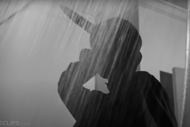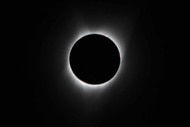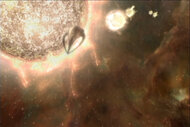Create a free profile to get unlimited access to exclusive videos, sweepstakes, and more!
Hold your breath and enter this hypnotic map of 25,000 supermassive black holes

There's no denying that black holes are the most destructive force in the universe, with their swirling, light-swallowing maw devouring anything that crosses its perilous event horizon.
As sophisticated modern instruments and deep space probes allow scientists to detect and study more about these mysterious objects, it's high time we have a proper roadmap of the churning phenomenon to adjust our starship trajectories by and save ourselves the potential nightmare of accidentally getting sucked into its enveloping clutches should we ever venture that far.
To aid in identifying the locations of these sinister sites, an international team of scientists led by The Netherland's Leiden University has recently submitted for publication a comprehensive map pinpointing the locations of 25,000 supermassive black holes to the journal Astronomy & Astrophysics.
With this handy new tool, astronomers and astrophysicists can observe this document of the night sky dusted with brilliant white lights denoting each known black hole, illuminated by the radio emissions of doomed matter getting absorbed and ejected after a close encounter.
In creating this detailed celestial map in the field of low radio frequencies, the astronomers participating in the project used 52 individual telescope stations with LOFAR antennas spread across The Netherlands, Germany, Poland, France, the United Kingdom, Sweden, Ireland, Latvia, and Italy. LOFAR (LOw-Frequency ARray) is a next-generation radio interferometer combined array constructed in the north of The Netherlands and completed back in 2012.
In its entirety, this cosmic cartography task required over 256 hours of observation and additional years of analysis before this breathtaking map, representing only 4% of the northern portion of the sky, could even be composed.
“This is the result of many years of work on incredibly difficult data,” research leader and former Leiden University scientist Francesco de Gasperin said in the official press release. “We had to invent new methods to convert the radio signals into images of the sky.”
To dial in the black hole emission details and place each candidate in its prospective galaxy, researchers employed supercomputers fortified with algorithms to correct the distorting effect of the ionosphere every four seconds.
Study co-author Reinout van Weeren of Leiden Observatory explained that the effect is like attempting to view the world from the bottom of a swimming pool, where your vision is affected by surface waves deflecting light rays and altering the clarity.
“After many years of software development, it is so wonderful to see that this has now really worked out,” Leiden Observatory’s scientific director Huub Röttgering noted.
With just a minuscule slice of the night sky scanned for supermassive black holes, the dedicated team intends on exploiting more of the new algorithm to continue mapping the northern sky in the immediate future and document more of its infinite wonders.
















